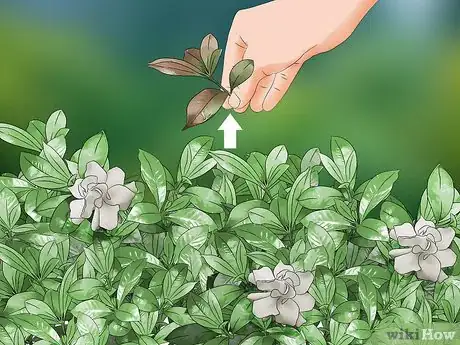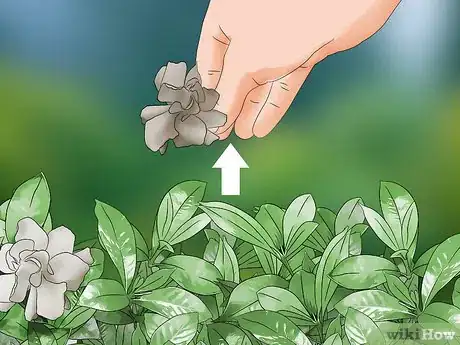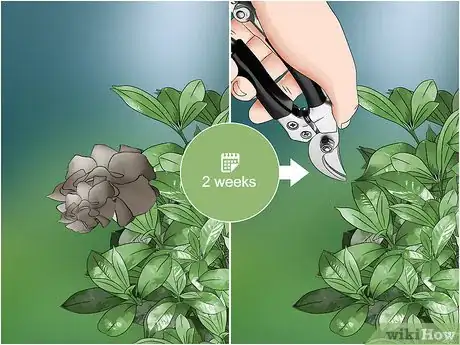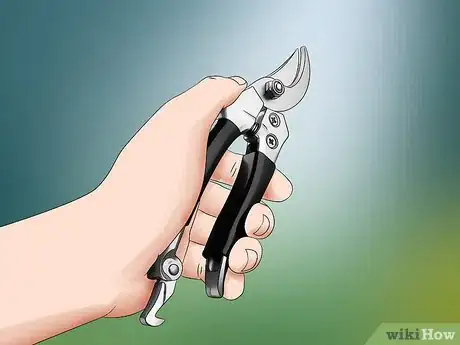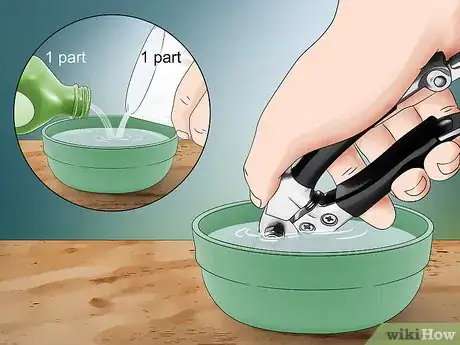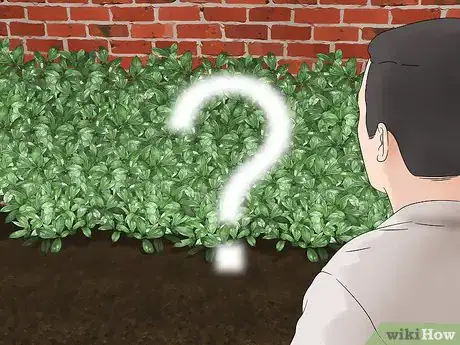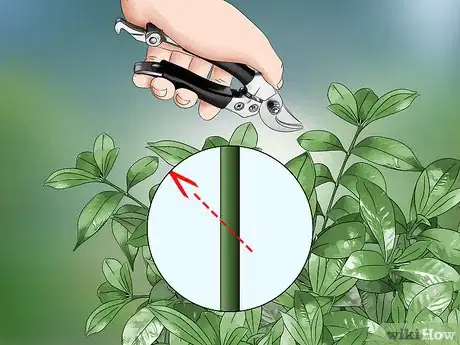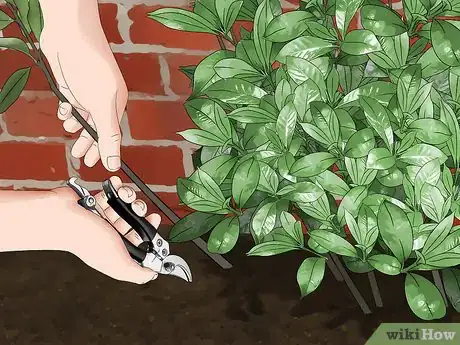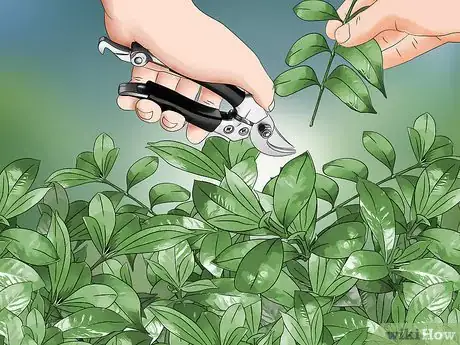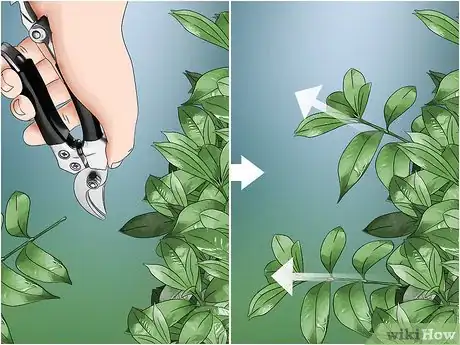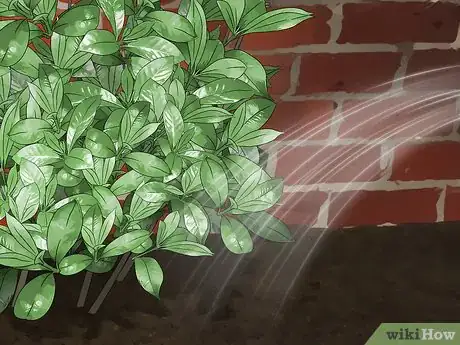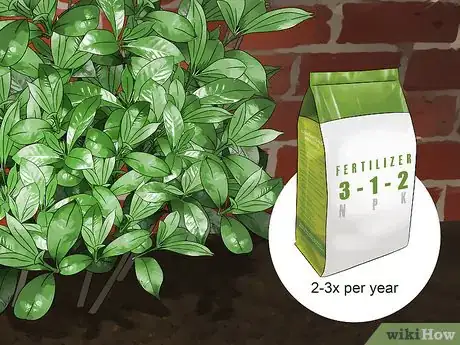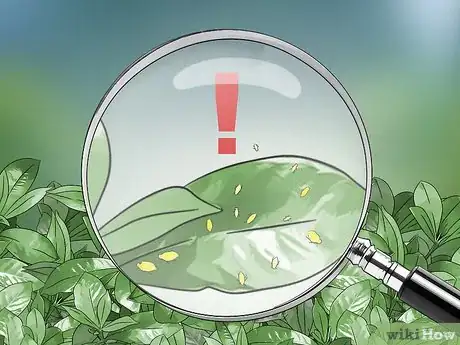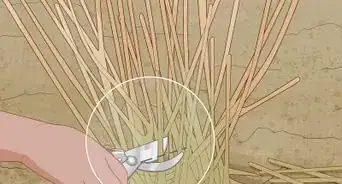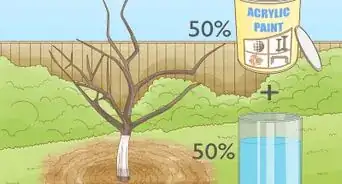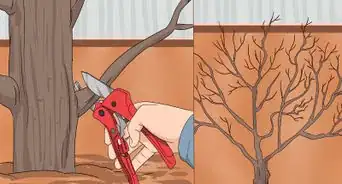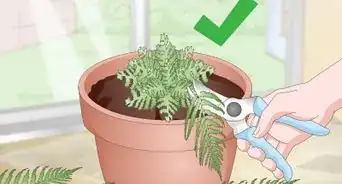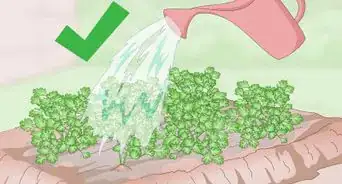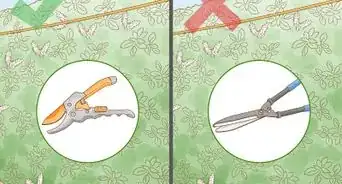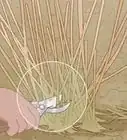This article was co-authored by Lauren Kurtz. Lauren Kurtz is a Naturalist and Horticultural Specialist. Lauren has worked for Aurora, Colorado managing the Water-Wise Garden at Aurora Municipal Center for the Water Conservation Department. She earned a BA in Environmental and Sustainability Studies from Western Michigan University in 2014.
wikiHow marks an article as reader-approved once it receives enough positive feedback. In this case, 96% of readers who voted found the article helpful, earning it our reader-approved status.
This article has been viewed 140,687 times.
Gardenia bushes are a lovely addition to any garden, but if left alone they can get a little scraggly. Make sure you prune after your gardenias are finished blooming, and that you use sharp pruning shears. You should first remove any dead blooms, and then trim back shoots that alter the natural shape of the gardenia bush.
Steps
Removing Dead Stems
-
1Pinch off dead stems with your fingers. Throughout its flowering season, regularly look over the plant for dead blooms – they’ll be brown or black and look generally unhealthy. With your thumb and index finger, pinch behind the swollen seed base that’s behind the base of the bloom. Pull the dead stem off the branch.[1]
- This practice is known as “deadheading.”
- You may need to use hand pruners for thicker stems.
-
2"Deadhead" your gardenia bush once a week during blooming season. Look for and pinch off dead or fading flowers once a week. Removing them regularly can encourage the growth of longer-lasting flowers, and can also increase the number of flowers that will bloom later.[2]Advertisement
-
3Time your pruning right. If you prune your gardenia bush with shears before it’s finished blooming, you could cause damage to the growing blooms. Instead, plan on pruning your gardenia bush after the blooming season is over, but before the daytime temperature falls below 65 °F (18 °C). You'll know it's time to prune the bush once see the flowers begin to fade. Prune the bush 1 or 2 weeks after the flowers fade.[3]
Pruning for Shape, Size, and Growth
-
1Use standard pruning shears when trimming gardenias. For branches that are up to 1.5 in (3.8 cm) thick, use common hand-held pruning shears. In the unlikely event that you have branches larger than that, use a narrow-bladed saw.[4]
-
2Disinfect your shears (and saw, if needed) before using them. Mix a solution of 1 part rubbing alcohol to 1 part water. Dip the blades into the solution, or apply it to a clean rag and wipe down the blades. However, if it's been awhile since you've used your shears, let the blades soak in the solution for 10 minutes or so. Then let your shears air dry.[5]
- You can also use a solution of 1 part bleach to 9 parts water.
- Wipe down the blades after cutting any diseased or infected branches, and when moving from one plant to another.
- If you don't disinfect your shears, you could accidentally transfer any insects or disease from one branch (or plant) to another.
-
3Step back to determine the size and shape of your gardenia bush. Stand far enough away from your gardenia bush that you can see the whole thing in comparison to the area around it. Then decide what size and shape you'd like the bush to be. Once you begin pruning, step back frequently to check to make sure you're maintaining the size and shape you want.[6]
-
4Hold the pruning shears at a 45-degree angle to the branch. This angle will help you cut through the branches easily. It also prevents you from damaging the main branches of the bush if you get too close.[7]
-
5Cut away half of the oldest branches at the trunk. Cutting the oldest, thickest branches will allow space for new growth. Depending on how overgrown your gardenia bush is, you might want to trim out more than half of the oldest branches.[8]
- The oldest branches tend to be the darkest shade of brown and the thickest.
-
6Trim the remaining branches down to your desired height and shape. After you've thinned out the oldest branches, trim the remaining branches. As you're trimming the branches, make sure you make cuts above a stem branch or leaf node to encourage new growth there.[9]
- The stem branch is where thinner stems branch off of thicker limbs. The leaf node is the bulge at the end of the leaf stem at the branch.
-
7Prune most where you want to encourage growth. In addition to pruning your gardenia bush to maintain its shape and size, you can prune to encourage growth in certain areas. If you prune back the bottom of the gardenia bush beyond the excess growth – up to a few inches – that area will tend to grow back fuller.[10]
Maintaining Your Gardenia Bush
-
1Water your gardenias regularly. Regular watering will promote thick foliage and bloom growth. The soil around your gardenia bush should almost always be moist. How often you'll need to water your gardenia bush will depend on how dry the weather is.[11]
-
2Fertilize your gardenia bush 2 to 3 times per year. One of the best times to fertilize your gardenia bush is after you prune it. Use a fertilizer with a a 3-1-2 or 3-1-3 ratio of nitrogen, phosphorus, and potassium. Follow the instructions on the fertilizer packaging for the amount you should use, and mix it into the soil around your gardenia bush.[12]
-
3Check for bugs on your gardenias. You should look for mealybugs, caterpillars, aphids, whiteflies, thrips, and spider mites. If you see any of these insects on your gardenia bush, try a natural remedy to remove them. If the infestation is bad, you may need to use an insecticide.[13]
- To get rid of aphids, spray them with water every 2-3 days until they disappear.
- For whiteflies and spider mites, try applying neem oil or insecticidal soap to your gardenia bush.
- Use your hands to pick caterpillars off your gardenia bush
Community Q&A
-
QuestionWhen can I trim a large gardenia bush?
 Addison SmithCommunity AnswerIt is best to prune your gardenia shrub right after the blooms have faded in the summer. Gardenias will set their flower buds the next year in fall, so pruning in the summer will allow you to cut back some of the older wood without the risk of cutting away newly set buds.
Addison SmithCommunity AnswerIt is best to prune your gardenia shrub right after the blooms have faded in the summer. Gardenias will set their flower buds the next year in fall, so pruning in the summer will allow you to cut back some of the older wood without the risk of cutting away newly set buds. -
QuestionWhen is it the best time to transplant gardenia plants?
 Addison SmithCommunity AnswerThe best time to transplant gardenia plants is in the fall, right after the plant has finished blooming. Gardenia plants transplant best when the weather is cool and the plant is slowing down. About a week before transplanting gardenia bushes, prune the branches back by one-quarter or one-third.
Addison SmithCommunity AnswerThe best time to transplant gardenia plants is in the fall, right after the plant has finished blooming. Gardenia plants transplant best when the weather is cool and the plant is slowing down. About a week before transplanting gardenia bushes, prune the branches back by one-quarter or one-third. -
QuestionCan I prune a 6-foot gardenia bush back to a 3-foot bush without killing it?
 Addison SmithCommunity AnswerTrim the branches by 2 to 3 inches just after flowering ends, from May to July. Do not prune any gardenia too late in the season, usually after August but as late as October in some areas. The resulting tender green shoots will not have time to harden and will be killed by a frost or freeze.
Addison SmithCommunity AnswerTrim the branches by 2 to 3 inches just after flowering ends, from May to July. Do not prune any gardenia too late in the season, usually after August but as late as October in some areas. The resulting tender green shoots will not have time to harden and will be killed by a frost or freeze.
References
- ↑ https://hgic.clemson.edu/factsheet/gardenia/
- ↑ https://gardenerdy.com/how-to-prune-gardenia-bush
- ↑ https://gardenerdy.com/how-to-prune-gardenia-bush
- ↑ https://www.youtube.com/watch?v=Qpb14zlvccQ
- ↑ https://gardenerdy.com/how-to-prune-gardenia-bush
- ↑ https://www.youtube.com/watch?v=Qpb14zlvccQ
- ↑ https://gardenerdy.com/how-to-prune-gardenia-bush
- ↑ https://www.youtube.com/watch?v=Qpb14zlvccQ
- ↑ http://www.monrovia.com/how-to-grow-gardenias/
About This Article
To prune a gardenia bush, wait until after blooming season but before the daytime temperature drops below 65 degrees Fahrenheit to avoid damaging the growing blooms. Start with the oldest, thickest branches, which will be the darkest shades of brown, to make room for new ones. Cut the branches at a 45-degree angle to prevent damaging the main branches if you cut too close. Once you’ve trimmed the oldest branches, prune the rest of the bush to your desired height and shape. If you want your bush to grow in certain areas, cut more branches from these places, since this should encourage new growth. For more tips from our Gardening co-author, including how to deadhead your gardenia bush each week, read on!
